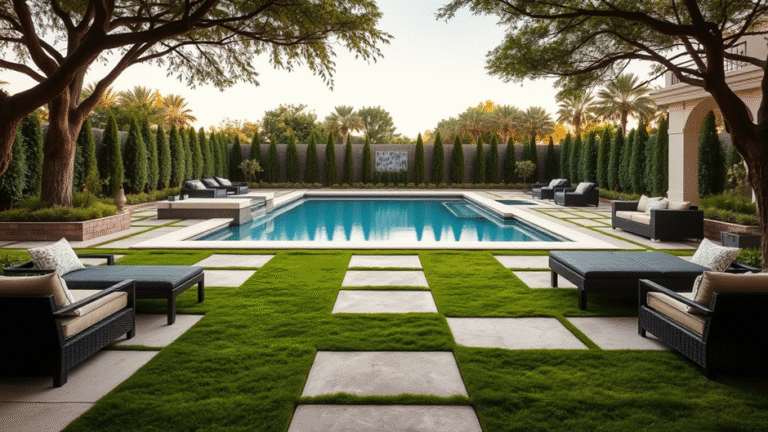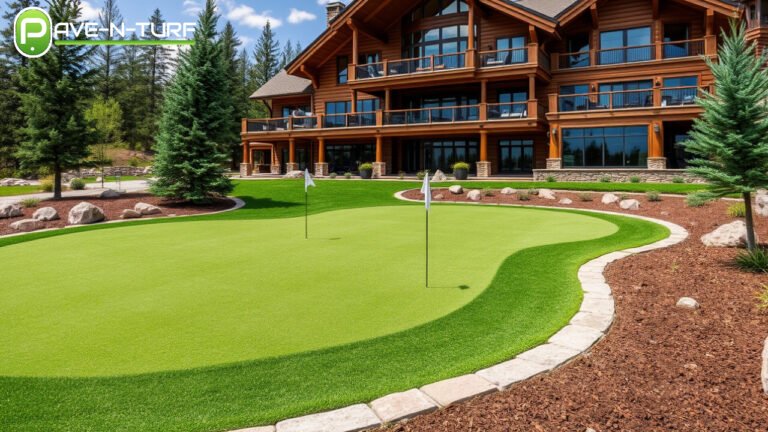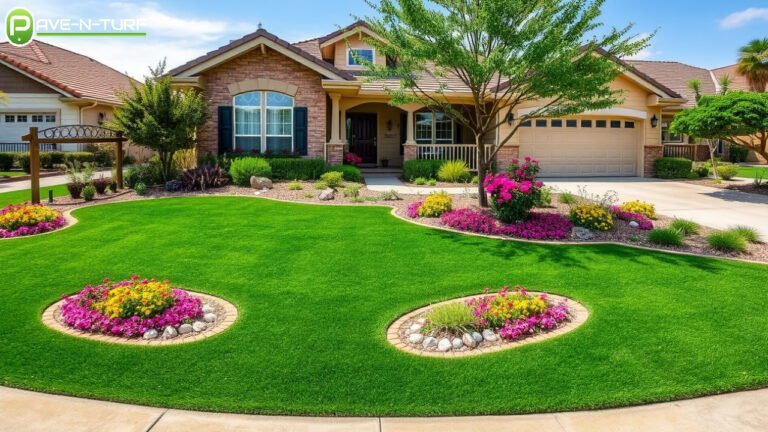Essential Tips for Cleaning Artificial Grass

Cleaning Your Artificial Grass
Artificial grass has become a popular choice for many landscape architects. Its aesthetic appeal and low maintenance requirements make it an attractive option for outdoor spaces.
However, to maintain its pristine condition and longevity, it may be a good idea to regularly clean it. This not only preserves the visual appeal of the turf but also contributes to a healthier environment.
This article provides a comprehensive guide on how to clean artificial grass. It covers everything from removing leaves and other debris to dealing with spills and stains.
We’ll also delve into eco-friendly cleaning methods that align with sustainable practices. These techniques ensure that your artificial turf remains vibrant and clean without harming the environment.
Even if you are a season landscaper or have owned artificial turf for years, this guide will help you learn and refresh some methods to help maintain your artificial turf clean and preserve its longevity.
Understanding the Importance of Artificial Grass Maintenance
Proper maintenance is crucial for keeping artificial grass in top shape. Regular cleaning helps retain its vibrant color and soft texture. This maintenance extends the lifespan of the turf, providing long-term value.
Leaves, dirt, and other contaminants can accumulate over time. If left unattended, they may cause the artificial turf to look worn and unappealing. Routine cleaning addresses this issue, ensuring it remains visually pleasing and functional.
Artificial grass also serves a practical purpose, reducing the need for frequent watering and mowing. However, without maintenance, drainage issues can arise, leading to waterlogging and odor problems.
The Aesthetic and Functional Benefits of Clean Artificial Grass
Clean artificial grass elevates the look of any landscape design. It provides a lush, green surface that mimics natural grass without its upkeep challenges.
Functionally, it offers a durable and resilient surface perfect for high-traffic areas. This makes it an ideal choice for both residential and commercial properties. Keeping the turf clean ensures it remains a beautiful and practical part of the landscape.
Environmental Advantages of Artificial Turf
Choosing artificial turf has significant environmental benefits. It eliminates the need for chemical fertilizers and pesticides, contributing to healthier ecosystems. Additionally, it conserves water, reducing the strain on local water resources.
Artificial grass reduces emissions from gas-powered maintenance equipment. This aligns well with sustainability goals and eco-friendly design practices. Overall, it offers both aesthetic appeal and environmental advantages, making it a wise choice for modern landscape architecture.
Identifying Common Contaminants and Debris
Artificial grass, while low-maintenance, can still fall victim to common contaminants. Dust and dirt, carried by wind or foot traffic, are frequent culprits. They can dull the turf’s color and texture if allowed to accumulate.
Leaves and twigs are typical debris found on artificial grass, especially during fall. They can obstruct drainage and create a breeding ground for pests if not promptly removed. Regular checks and swift action are key to maintaining turf hygiene.
Pet waste and spills also pose challenges, affecting both the visual appeal and integrity of the grass. Proactive cleaning prevents these contaminants from causing long-term damage. Moreover, maintaining cleanliness discourages mold and odors from developing.
How to Clean Artificial Grass Leaves and Other Organic Matter
Keeping your artificial grass free of leaves and organic debris is straightforward but requires consistency. A few easy methods can effectively address this issue. First, employ a leaf blower to quickly move lighter debris off the surface.
For more stubborn debris, consider using a rake with plastic tines. This helps to gather items without damaging the turf fibers. Regularly inspect the artificial grass to catch debris early before it starts to decay or mat down.
Here’s a concise checklist to clear organic matter:
- Use a leaf blower for swift removal.
- Rake leaves gently with a plastic rake.
- Bag and properly dispose of collected debris.
- Use an electric power broom
These steps ensure your turf remains clean and prolongs its aesthetic appeal. Effective debris management enhances the functionality and beauty of your artificial grass.
Regular Cleaning Techniques for Artificial Grass
Maintaining artificial grass requires regular cleaning, despite its low-maintenance appeal. Basic techniques can keep the surface looking fresh. Regular cleaning prevents debris buildup, discourages mold, and maintains the grass’s vibrancy.
Weekly rinsing with a garden hose is effective, especially in dusty or high-traffic areas. This method dislodges dirt and small particulates effortlessly. Ensuring proper drainage during rinsing is crucial to avoid water pooling.
In addition to rinsing, brushing is vital for redistributing the infill, which supports the grass fibers. Consistent brushing helps maintain the upright appearance of the artificial grass, enhancing its natural look.
Consider establishing a routine cleaning checklist, which may include:
- Weekly rinsing with a garden hose
- Routine brushing against the grain
- Monthly deeper clean with mild soapy water
- Inspecting and replenishing infill as needed
These methods ensure artificial grass remains a pristine element of your landscape design. A well-maintained surface is both aesthetically pleasing and practical, contributing to a sustainable exterior.
Spot Cleaning Spills and Stains
Spills are inevitable, but quick action prevents stains from setting into artificial grass. Start by blotting liquid spills with a clean cloth, absorbing as much of the spill as possible without rubbing.
For more stubborn stains from food or drinks, use a mixture of water and mild dish soap. Apply gently with a soft brush, ensuring to rinse thoroughly afterward. This prevents soap residue from attracting more dirt.
Sticky substances like gum or candy can be chilled with an ice cube before being gently scraped off. If chemical cleaners become necessary, ensure they are appropriate for artificial turf to avoid damage. Regular vigilance ensures spills are managed promptly, preserving the turf’s integrity.
Using Natural Cleaning Agents
For eco-conscious landscape architects, natural cleaning agents offer a sustainable way to maintain artificial grass. Vinegar and water mixed in equal parts can effectively clean without harming the turf or the environment.
Baking soda can also address odor issues, particularly in spaces frequented by pets. Simply sprinkle, let sit, and rinse thoroughly. These natural options are both effective and gentle, aligning with sustainable design practices.
By choosing non-toxic materials, you protect not only the artificial grass but also the broader landscape environment. These options support sustainability in landscape architecture while maintaining high cleaning standards.
Maintaining Artificial Grass: Frequency and Methods
Regular maintenance of artificial grass is crucial for sustaining its beauty and functionality. While it doesn’t demand watering or mowing, consistent care prolongs its lifespan. Establish a routine for cleaning to keep your turf at its best.
In terms of frequency, aim for a weekly inspection and cleaning for high-traffic areas. This routine ensures timely removal of debris and maintenance of the grass’s structure. Low-traffic areas may require less frequent attention, but don’t neglect them.
A comprehensive maintenance plan might include these key tasks:
- Weekly inspection for debris or damage
- Regular brushing to maintain fiber integrity
- Monthly deep cleaning to address accumulated dirt
- Monitoring and adjusting infill levels
By following these steps, your artificial grass will stay strong and attractive in any outdoor space. This shows your skill in design and your dedication to quality.
Brushing and Raking for a Natural Look
Brushing and raking are essential to mimic the natural look of grass. These actions help upright the grass blades, keeping them resilient and natural-looking. Using a brush with soft bristles prevents fiber damage.
Regular brushing should counteract matting from foot traffic, ensuring the fibers stay upright. A soft rake can aid in redistributing infill evenly, maintaining the grass’s support and cushioning effect. These practices enhance visual appeal and structural support, reflecting attentive landscape management.
Preventing and Managing Weeds and Moss
Even though artificial grass offers a barrier to weeds, occasional intrusions can occur. Proactive measures will maintain your lawn’s seamless appearance. A weed membrane is usually used during installation to deter growth.
For existing weeds or moss, spot-treat them with an eco-friendly herbicide. This minimizes environmental impact while effectively managing plant growth. Regular inspection helps catch weed or moss growth early, keeping your landscape pristine. These methods integrate sustainability, aligning with environmentally conscious design principles.
Special Considerations for Pet Owners
Pet owners often choose artificial grass for its durability and ease of maintenance. However, managing pets on synthetic turf requires specific attention to cleanliness. Regular upkeep prevents odor buildup and maintains the lawn’s appearance.
Pet urine won’t damage the fibers but can result in smell if not promptly addressed. Installing a well-constructed drainage system ensures quick removal of liquid waste, reducing odors. Plus, regular rinsing with water and mild cleaners helps refresh the turf.
Fencing off a specific area within the lawn may also aid in waste management. This localized approach allows for easier cleanup and prevents widespread contamination. Clear communication with clients about these strategies helps them maintain a comfortable and hygienic space for their pets.
Addressing Pet Waste on Artificial Grass
For solid waste, immediate removal prevents bacteria from embedding in the grass fibers. Use a scooping tool to lift it without smearing. Follow up with a water rinse to cleanse the area.
Incorporating biodegradable cleaning agents further enhances odor control. These natural solutions neutralize smells without harming the turf or the environment. Encouraging clients to follow these steps helps them enjoy a pristine lawn, free from pet waste issues.
Seasonal and Specialized Cleaning Tips
Artificial grass requires unique care in response to seasonal shifts. Keeping in mind how weather impacts maintenance is key for sustaining its longevity. Tailoring your cleaning routine ensures that the turf remains immaculate year-round.
During autumn, leaves and debris are common nuisances. Utilize a leaf blower or a soft broom to clear these elements regularly. This not only prevents decay but also maintains drainage efficiency.
In winter, snow and ice present distinct challenges. Here are some tips:
- Use a plastic shovel to remove snow without scraping the grass.
- Avoid salt and chemicals, which could harm the fibers.
- Let sunlight aid in naturally melting ice patches.
Keeping an eye on weather trends and changing your maintenance routine helps the artificial grass stay in good shape and look nice all year long.
Handling Tough Stains and Winter Care
Tough stains, like oil or gum, require prompt and careful attention. Ice can freeze gum, making it easier to gently scrape off. For oils, a mild detergent followed by thorough rinsing works best.
Winter weather can affect fiber quality if not addressed. When snow builds up, clearing it by hand protects against excess weight and potential damage. By employing these strategies, you can prevent major issues and maintain the lawn’s durability during harsh weather.
The Role of Professional Cleaning Services
While regular DIY maintenance is crucial, professional cleaning services offer significant benefits. Experts bring specialized tools and techniques that can rejuvenate your artificial grass, reaching areas that might be overlooked in routine clean-ups. These services typically include deep cleaning processes, which can extend the lifespan of the turf by maintaining its vibrant appearance and structural integrity. Moreover, professionals can assess the overall condition of your artificial grass and provide tailored advice, ensuring it looks pristine throughout the year. Engaging with experienced cleaners ensures expert care, which is essential for any high-traffic or large-scale installations.
Most companies that install artificial turf typically provide maintenance services.
When to Consider Deep Cleaning by Experts
Certain scenarios necessitate the expertise of professional cleaners. If your artificial grass experiences heavy use or has accumulated hard-to-remove stains, it might be time for a deep clean. Professionals are also invaluable after winter or during post-construction clean-ups, where debris may infiltrate the grass. Consulting experts can improve the surface’s aesthetic and functional appeal, handling challenges that might be impractical for individual efforts. By leveraging their expertise, you ensure your grass remains not just clean but also lush and inviting, enhancing the overall value of your outdoor spaces.
Conclusion: The Value of Clean Artificial Grass in Landscape Design
Clean artificial grass significantly enhances the visual and functional aspects of any landscape project. It creates a polished and inviting space that aligns with eco-friendly landscaping practices. By maintaining its cleanliness, you help preserve the artificial grass’s bright hue and lush texture, ensuring a welcoming environment year-round.
Regular maintenance not only optimizes usability but also contributes to the longevity of your investment. In landscape design, this attention to detail ensures the space remains aesthetically pleasing, reflecting both quality and sustainability. A well-maintained artificial landscape showcases the intersection of beauty and environmental responsibility.
Integrating Cleaning into Sustainable Practices
Incorporating artificial grass cleaning into sustainable landscaping practices is vital for holistic maintenance. Using eco-friendly cleaning agents reduces environmental impact while preserving the turf’s integrity. This approach aligns with broader sustainability goals, promoting responsible stewardship of outdoor spaces. Encouraging water conservation through methods like rainwater harvesting further integrates ecological considerations into maintenance routines. As landscape architects, balancing cleanliness with sustainability not only elevates design quality but also reinforces commitment to eco-conscious practices. By embedding these routines, you ensure artificial grass remains both a sustainable and a visually stunning element of your projects.
Why Pave-N-Turf Should Be Your Next Call
At Pave-N-Turf, creating your perfect artificial grass space isn’t just a job, it’s what we’re passionate about. From the initial design to the final install, our team uses proven methods and advanced installation techniques to deliver a yard that looks greener, lasts longer, and feels better every season.
With years of hands-on experience, we don’t just install turf, we guide you through how to care for it, so your investment keeps paying off for years to come.
If you’re ready to spend less time maintaining your yard and more time enjoying it, let’s talk. Your low-maintenance, year-round green lawn is just a call away.






